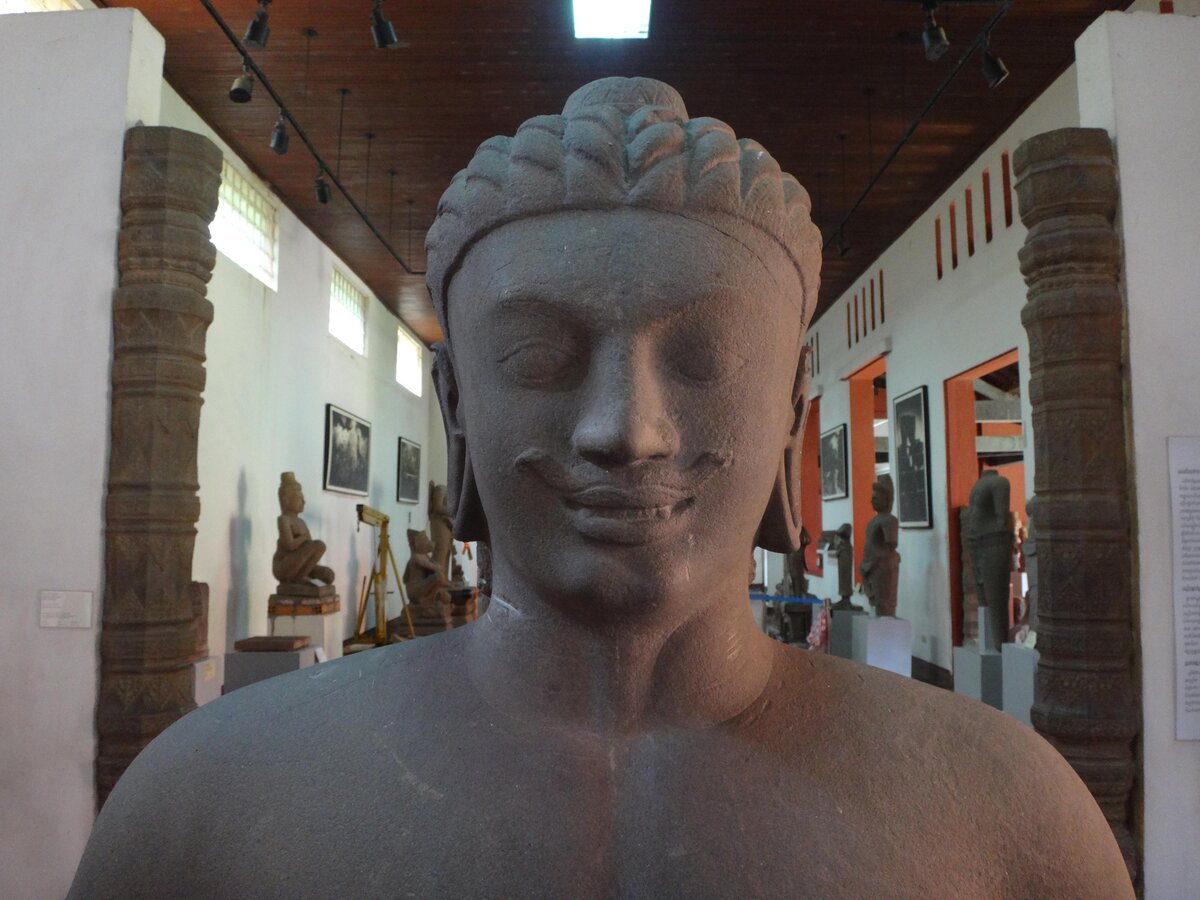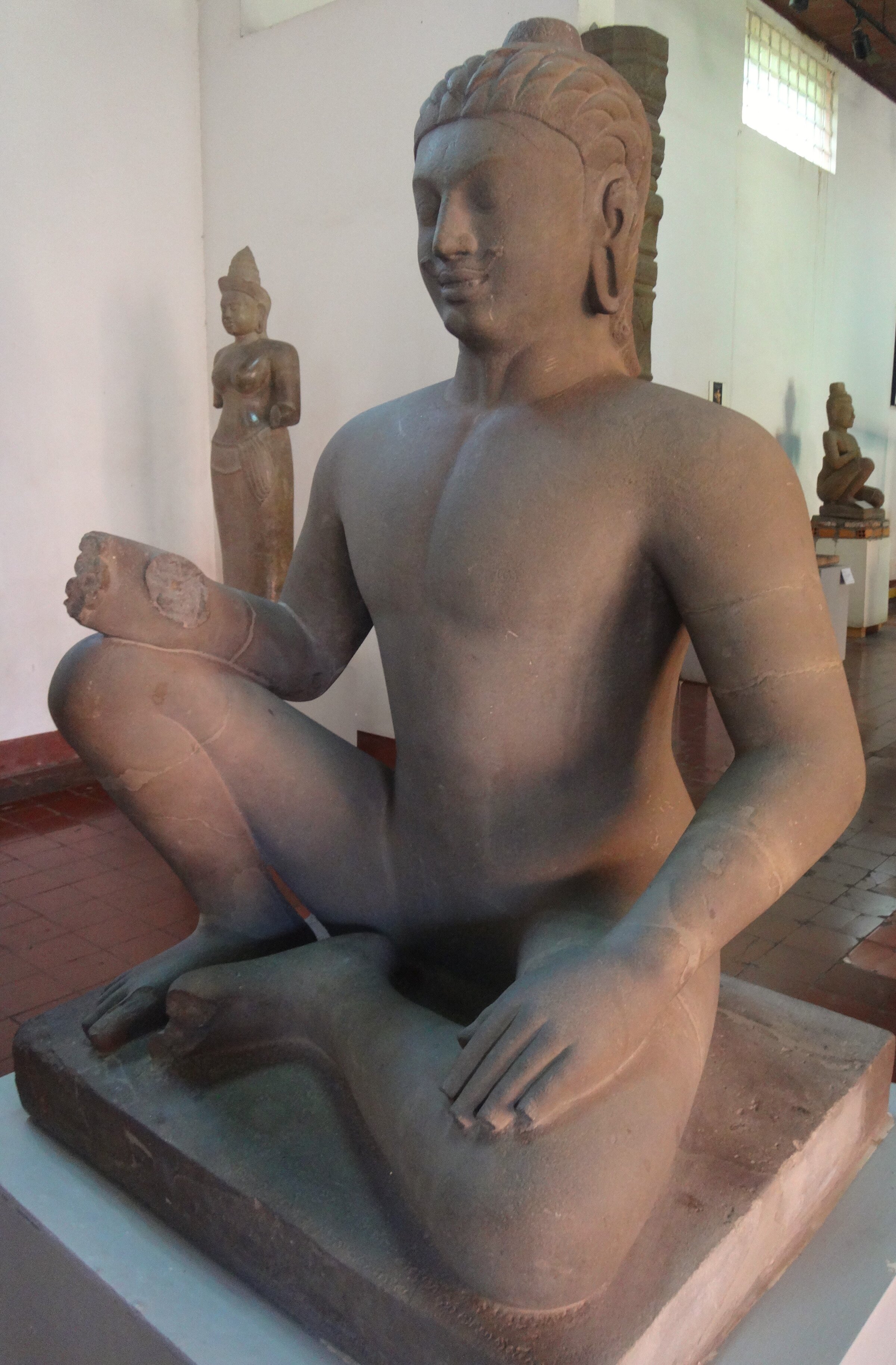Leper King or Yama – Terrace of the Leper King
by Andy Brouwer
Entry #10 in Khmer Art Worldwide Collection

Published: 2021
Author: Andy Brouwer
This statue is one of the most recognizable in Cambodia’s history. However, despite its notoriety, there is still debate over who it is, what it represents and when was it carved from sandstone and placed on the top of the Terrace of the Leper King, at the great city of Angkor Thom. The name of the Terrace gives the game away – to many it’s known as the statue of the Leper King, a common story told by tour guides and locals for decades. However, for scholars, some argue that it represents Yama, the god of Death and of Judgement, and that the story of the Leper King is a fictional tale, not based in fact. Who is right?
The statue represents a naked male figure with an athletic torso and platted hair but no genitals, most likely to avoid the concept of sexuality. His face has a moustache with two fangs emerging from his lips. He is shown seated with his right knee raised, likely carrying a mace on his right shoulder, similar to Yama shown in bas-reliefs at Angkor Wat, while his left arm rests on his leg.
Under the hot sun and due to intense tropical weathering, the statue suffered corrosion and patches of lichen, giving an impression of a skin disease, which when connected to its location on the Royal Terrace, the legend of the Leper King was born and embellished by French scholars in the late 19th century. It also made some sense as there was evidence that there was a King with leprosy in the distant past. However, scholars generally concur that it represents Yama, as the Terrace was used for ceremonial cremations and a statue of the God of Death fits the bill. You decide which story you prefer to believe.
The statue pictured here in the National Museum’s collection is in remarkably good condition. Up close, it’s almost perfect but you can see a few chips on the fingers and toes and the left arm has been meticulously reattached. It’s not the most artistic of images, in fact it’s quite plain, which may’ve saved it from being looted or destroyed for so long. It seems to have remained on top of the Terrace since its construction, possibly in the 13th century, though it bears an inscription, written a century later, that says: ‘His Majesty has made an offering on a small plate to His Majesty Dharmadhipati-adhiraja [meaning Yama]. Whoever will take this offering shall be handed-over the tortures [of hell], and could the powerful Buddhas of the future not make them free’. That could mean it’s dated from the 14th century, though other experts suggest it’s pre-Angkorian. Only a carbon-dating test of the stone may find the truth.
In 1967, in response to an attempted robbery and for safekeeping, the statue was taken to the Angkor Conservation Depot and then moved to the National Museum in Phnom Penh in the same year. Initially it was placed in the center of the museum courtyard before being later moved to the gallery, where it resides today. In its place on the Terrace and in the courtyard of the museum, cement copies were installed.
Tags: Leper King, Yama, Terrace of the Leper King, Bayon style, Khmer sculpture, museums, National Museum of Cambodia, legends
About the Author

Andy Brouwer
Cheltenham-born and bred, Andy Brouwer (1959, UK) made his first trip to Cambodia in 1994, and that white-knuckle ride hooked him for life. He upped sticks to Phnom Penh in 2007 after more than thirty years in banking back in the UK to join Hanuman Films.
As well as having a serious obsession in temples, books -- he’s the editor of the guidebook To Cambodia With Love --, and pretty much all things Khmer, he is a lifetime supporter of Leeds United and has an insatiable passion for the music of Steel Pulse and Ennio Morricone. His website relives his numerous visits to Cambodia, and more.
During his time living in Cambodia, he’s been a producer and researcher for Hanuman Films, a product manager at Hanuman Travel, and the media officer with Phnom Penh Crown FC. Since 2020, he developed a personal research, Exploring Khmer Art Worldwide, published as an ongoing series on his Facebook page, that will be soon hosted on Angkor Database.




